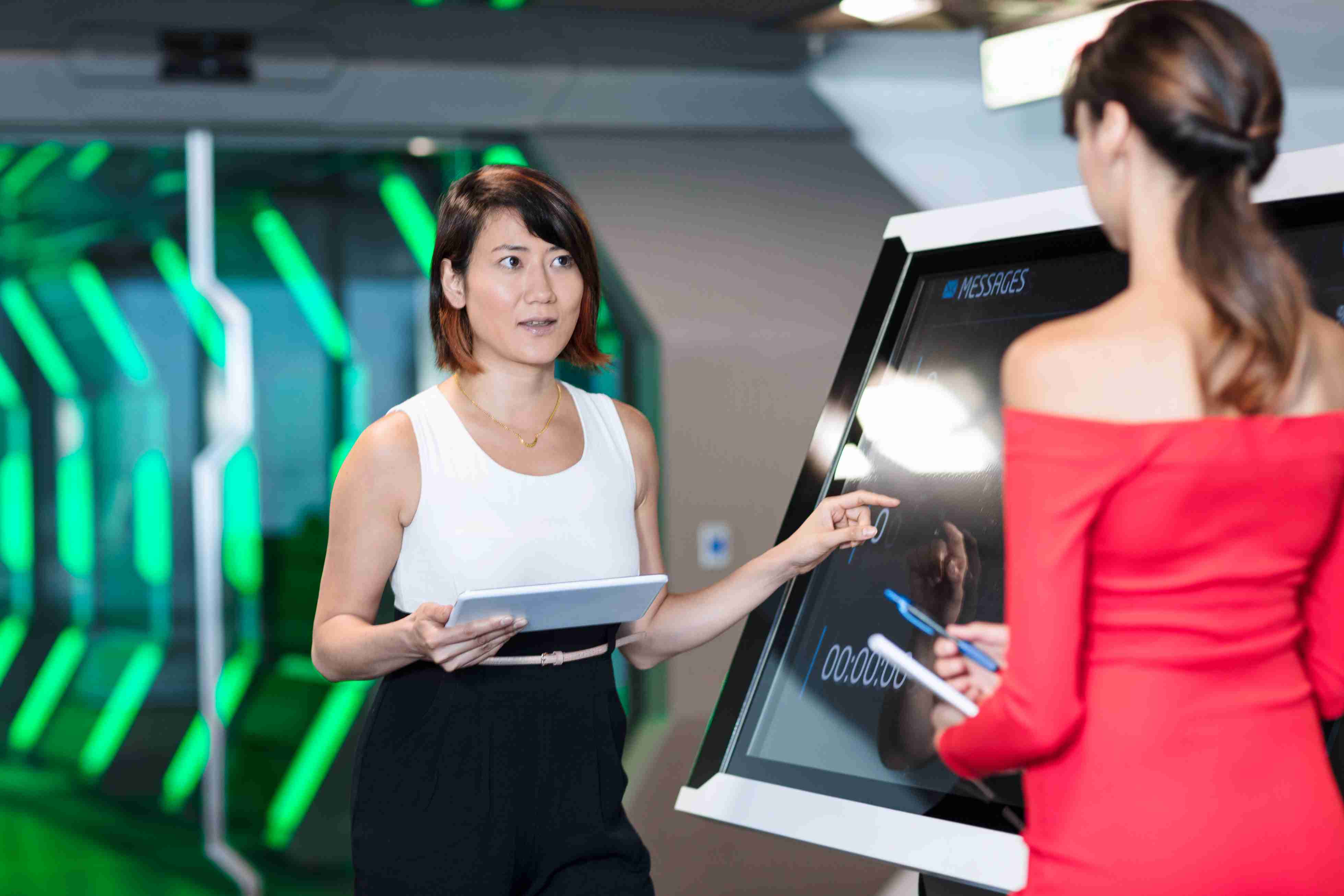Jan 31, 2025
Digital Solution
2 Comments
Interactive Tech Integration: Your Guide to Transforming Engagement
Interactive tech integration combines cutting-edge tools like touch interfaces, augmented reality (AR), virtual reality (VR), artificial intelligence (AI), and the Internet of Things (IoT) to create dynamic, engaging solutions.
From education and healthcare to retail and corporate environments, integrating interactive technology enhances productivity, improves user experiences, and opens new avenues for innovation.
In this comprehensive guide, we explore the concepts, benefits, and applications of interactive tech integration, along with actionable insights for implementing these technologies effectively.
What Is Interactive Tech Integration?
Interactive tech integration refers to incorporating interactive technologies into various systems, devices, and processes to enhance user engagement and streamline workflows. It combines hardware and software solutions that allow users to interact with digital content in real time, often through touch, voice commands, gestures, or immersive interfaces.
For example, a retail store might use interactive tech like AR mirrors that let customers virtually try on clothing, while a corporate office might implement IoT-enabled smartboards for collaborative work. The goal is to create seamless, intuitive experiences that bridge the gap between humans and technology.
Organizations across industries are increasingly leveraging interactive tech to enhance customer engagement, optimize operations, and drive innovation.
The Evolution of Interactive Technology
The journey of interactive tech integration began with the advent of simple touch interfaces and motion sensors. Over the years, advancements in AI, machine learning, and connectivity have given rise to more sophisticated tools, including:
• Touchscreen kiosks for retail and public spaces.
• Voice-activated assistants like Alexa and Google Assistant.
• IoT-powered devices that connect physical objects to digital ecosystems.
• Immersive AR/VR experiences for education, training, and entertainment.
Today, interactive technology is a cornerstone of digital transformation, driving innovation across industries.
Key Components of Interactive Tech Integration
1. Hardware Solutions
Interactive technologies often rely on physical devices such as:
• Touchscreens: Used in kiosks, smartboards, and mobile devices.
• Sensors and Cameras: Enable gesture recognition and motion tracking.
• Wearables: Devices like smartwatches and AR glasses.
• IoT Devices: Connect and automate physical systems, such as lighting or climate control.
2. Software Platforms
Software drives the interactivity, enabling real-time responses and data analysis. Examples include:
• Augmented Reality Applications: AR overlays for enhanced experiences.
• AI Algorithms: Personalize content and automate interactions.
• Collaboration Tools: Software like Zoom or Microsoft Teams with interactive whiteboards.
3. Connectivity Infrastructure
Interactive tech relies on robust connectivity, often facilitated by:
• Wi-Fi Networks: For seamless device communication.
• Cloud Computing: To store and process data in real time.
• 5G Technology: Enhances speed and reduces latency.
Benefits of Interactive Tech Integration
1. Enhanced User Engagement
Interactive technology creates personalized, dynamic experiences that captivate users and encourage deeper involvement. Whether it’s AR shopping tools that let customers visualize products in real-time or gamified learning platforms that motivate students, interactive tech turns passive participation into active engagement. This heightened interaction fosters loyalty and makes experiences more memorable.
2. Improved Efficiency
By automating routine tasks and simplifying workflows, interactive technology helps organizations save time and resources. For instance, IoT-enabled smart offices can automate lighting and temperature control, while AI-driven scheduling tools streamline meeting organization. These improvements allow teams to focus on more strategic initiatives, reducing operational bottlenecks.
3. Better Decision-Making
Interactive technologies collect and process vast amounts of real-time data, offering actionable insights. For example, retail businesses can analyze AR-driven shopper interactions to refine their marketing strategies, while healthcare providers can use telemedicine data to improve patient outcomes. This informed decision-making results in more effective and targeted solutions.
4. Scalability
Interactive tech solutions are inherently scalable, allowing businesses to grow their capabilities without significant overhauls. Cloud-based systems, in particular, enable seamless updates and expansions, ensuring organizations can adapt to changing needs. For example, a company might start with a single smartboard and expand to fully connected IoT systems across multiple offices.
5. Cost Savings
Though the initial investment may be significant, interactive technology offers long-term cost benefits by optimizing resource use. Automation reduces labor costs, while smart systems lower energy consumption. In industries like manufacturing, IoT sensors can prevent costly equipment failures through predictive maintenance, saving money over time.
Applications of Interactive Tech Integration
1. Retail and E-Commerce
Interactive tech revolutionizes the retail landscape by merging convenience with engagement.
• Virtual Try-Ons: AR mirrors let customers see how clothing or makeup would look without physically trying them on, enhancing shopping convenience.
• Interactive Displays: Touchscreens provide product details, reviews, and custom recommendations, enriching the in-store experience.
• Personalized Recommendations: AI analyzes customer behavior to suggest products tailored to individual preferences, boosting sales and satisfaction.
2. Education and Training
The education sector benefits immensely from interactive technologies that make learning more engaging and accessible.
• Smart Classrooms: IoT-connected boards and devices facilitate interactive lessons, fostering collaboration among students and teachers.
• VR Simulations: Virtual environments allow students to practice complex skills, like performing surgeries or operating machinery, in a risk-free setting.
• Gamified Learning: Interactive platforms transform traditional lessons into fun challenges, encouraging higher participation and knowledge retention.
3. Corporate Workspaces
Businesses use interactive technology to enhance productivity and streamline operations.
• Interactive Whiteboards: Teams can brainstorm and collaborate remotely in real-time, reducing the need for physical meetings.
• IoT-Enabled Offices: Automated systems manage energy use, security, and environmental controls, improving workplace comfort and efficiency.
• AI-Powered Tools: Chatbots and virtual assistants handle administrative tasks, freeing employees to focus on strategic projects.
4. Healthcare
Interactive technologies are revolutionizing patient care and medical training.
• AR-Assisted Surgeries: Surgeons use augmented reality to visualize anatomical structures, improving precision during procedures.
• Telemedicine Platforms: Patients access consultations and health monitoring remotely, reducing barriers to care.
• Patient Engagement Tools: Self-service kiosks simplify check-ins, update medical records, and reduce wait times, enhancing overall satisfaction.
5. Entertainment and Gaming
The entertainment industry uses interactive tech to deliver immersive and customizable experiences.
• AR and VR Gaming: Players step into virtual worlds where they can interact with the environment, creating unprecedented levels of engagement.
• Live Event Enhancements: Concerts and sports events incorporate AR apps that provide additional content, like player stats or alternate camera views.
• Streaming Services: AI recommends tailored content based on user preferences, ensuring a highly personalized viewing experience.
For an example of how interactive web solutions are transforming experiences, take a look at this interactive web solution example.
6. Smart Cities
Interactive tech plays a vital role in urban innovation and infrastructure management.
• Smart Traffic Systems: IoT-enabled sensors analyze traffic flow and adjust signals in real-time, reducing congestion.
• Public Kiosks: Interactive booths provide residents and tourists with navigation, event details, and public transport schedules.
• Environmental Monitoring: Sensors track air quality, noise levels, and weather data, enabling cities to implement eco-friendly initiatives.
Steps to Implement Interactive Tech Integration
1. Assess Needs and Goals
Start by identifying specific challenges and opportunities where interactive tech can deliver value. For instance, a retailer might aim to improve customer engagement through virtual try-ons, while a corporate office could focus on automating meeting room scheduling. A clear understanding of objectives ensures the investment aligns with organizational priorities.
2. Choose the Right Technology
Choosing the right tools is super important for successful integration. Consider factors like scalability, user-friendliness, and compatibility with existing systems. For example, a small business might opt for cost-effective touchscreen kiosks, while a tech-driven organization may invest in advanced IoT systems.
3. Plan Infrastructure Requirements
Interactive technology often requires robust infrastructure, including reliable connectivity, compatible hardware, and secure software platforms. Ensure that your network can handle the increased data load and that cloud storage is secure enough for sensitive information.
4. Train Staff
Proper training ensures employees can use interactive tools effectively. For example, sales associates in a retail setting might need to learn how to operate AR apps, while office teams may require workshops on using interactive whiteboards for collaboration.
5. Monitor and Optimize
Once deployed, track the performance of interactive technologies through analytics. Metrics like user engagement, error rates, and feedback help identify areas for improvement. Regular updates and refinements keep the system running efficiently and meeting evolving needs.
Challenges in Interactive Tech Integration
1. High Initial Costs
Implementing interactive technology can require significant investment in devices, software, and training. While the upfront costs may deter some organizations, long-term benefits such as improved efficiency and cost savings often justify the expense. Exploring scalable solutions can help balance costs and benefits.
2. Technical Complexity
Integrating new technologies into existing systems can be challenging, especially for organizations with outdated infrastructure. Collaborating with experienced vendors and IT teams ensures smooth deployment and minimizes compatibility issues.
3. Data Privacy Concerns
As interactive technologies collect and process vast amounts of user data, privacy becomes a significant concern. Organizations must comply with regulations like GDPR and implement strong security measures, including encryption and regular audits, to protect sensitive information.
4. User Adaptation
Not all users are comfortable with new technology, which can hinder adoption rates. Designing intuitive interfaces and offering step-by-step guidance ensures a smoother transition, making the tools accessible to all users regardless of technical expertise.
The Future of Interactive Tech Integration
1. AI-Driven Personalization
As AI advances, its ability to understand and predict user behavior will grow. This will enable hyper-personalized experiences, such as recommending products based on shopping history or tailoring educational content to individual learning styles, enhancing engagement and satisfaction.
2. Expansion of AR and VR
With decreasing costs and improving accessibility, AR and VR technologies will see widespread adoption across industries. For example, AR-powered manuals could assist factory workers in real time, while VR could revolutionize remote work and virtual conferences by creating realistic, collaborative environments.
3. Integration with Blockchain
Blockchain will enhance the security and transparency of interactive tech applications, particularly in sectors like finance and supply chain management. For instance, interactive systems could leverage blockchain to authenticate transactions or track product origins in real time.
4. Voice and Gesture Control
Advances in natural language processing and gesture recognition will make interactions more intuitive. From controlling smart homes with voice commands to navigating AR interfaces through hand gestures, these innovations will simplify user experiences and reduce barriers to adoption.
5. Hybrid Physical-Digital Environments
The line between the physical and the digital continue to blur. Imagine smart homes where AR projections show energy usage, or smart cities where interactive kiosks offer real-time updates on public services. These environments will offer seamless transitions between the digital and physical realms, enhancing convenience and functionality.
Conclusion
Interactive tech integration is redefining how industries operate, communicate, and engage with their audiences. By combining advanced tools like AI, IoT, AR, and VR, organizations can create immersive experiences, streamline workflows, and unlock new opportunities for growth.
As technology continues to advance, integrating interactive solutions will become a necessity rather than a luxury. Embracing these innovations today ensures that businesses and communities remain competitive and future-ready in an increasingly digital world.
Tags
Digital





